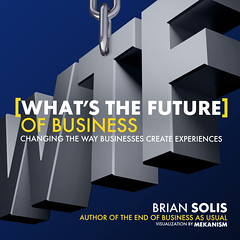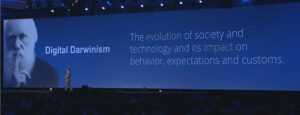We are indeed witnessing what can be best described as the end of business as usual. With the closure or dwindling performance of businesses once regarded as too big to fail or with the rise of every new Occupy-like movement around the world, we are reminded of the grand chasm that exists between consumer values and the values of today’s businesses. What is becoming painfully obvious is that people everywhere are calling for change and they’re taking to the streets and also their smartphones, tablets, and popular social networks to demand attention.
The reality is that people are much more connected than ever before and their mission is to not only mind the gap, but narrow it. Technology is a game changer and through the devices and networks that connect consumers, it is also the critical path for businesses to earn and re-earn relevance and trust. Without evaluation or introspection, businesses however may well face digital Darwinism, the evolution of consumer behavior when society and technology evolve faster than the ability to adapt.
On April 21st 2011, Forbes ran a sobering article that carried an ominous prediction, “If the current trend continues, over 70% of Fortune 1000 companies will turnover from 2003 to 2013.” Change is in the air and what the relationships between customers, stakeholders and businesses look like from here forward is uncertain. But, it is in the attempts at defining meaningful relationships where businesses will find guidance moving forward.
Think about it for a moment. Today’s biggest trends- the mobile web, social media, gamification, real-time- are changing the consumer landscape. Everyday people are empowered and influential. What we must realize however is that consumers are learning how to improve their online experiences and as a result, it is forcing individuals to think and re-think about the people, organizations, and information they choose to connect with. You are either part of the equation or you’re not.
While this is the end of business as usual, it is also the beginning of a new era of relevance. Businesses now have an opportunity to become relevant in new channels and networks by earning attention and forming meaningful alliances. To do that takes far more than gimmicks, creative marketing, contests and viral videos. It takes the consistent delivery of value based on ongoing listening and meaningful engagement.
The reality is that how this new breed of connected consumers discovers, shares, and communicates differently than their traditional consumer counterparts. To connect with them requires study to identify challenges, themes, POVs, and interests. To adapt, organizations need to examine the impact of technology on consumer behavior and understand its affect on how connected consumers make decisions and influence the decisions of their peers.
People have uninhibited access now to social platforms, channels and tools to express themselves at will. And, people too have an offline and online voice that when used individually and collectively, they can reach the masses and organize movements that cause everything else to pause for reflection. Yet, even though we know this, businesses are still struggling to understand the real impact of connected consumerism. Many still wonder if this is all just a fad.
At the heart of this consumer revolution is the need for people to be heard and for them to see that action is taken on their behalf. Technology serves as the glue that bring like-minded people together. This is why relationships are now more important than ever. Even though people are connecting in social networks, just creating a presence on Facebook or Twitter isn’t enough to show that you’re listening. Nor does it convey empathy or a new vision. Hosting conversations or getting people to follow you on Twitter or Like you on Facebook is one thing. But, to connect and foster real relationships, organizations must learn how to dedicate resources to listen, learn and adapt the processes, systems, experiences and prevailing culture that will entice and nurture consumer engagement.

The reality is that we live and compete in a perpetual era of Digital Darwinism. But, nothing today is too big to fail nor too small to succeed as long as relevance and value are in scope. Even though technology may seemingly play a role in working against your business, it can also work for you. The good news is that you have a role in defining where all of this goes.
Everything begins with learning how and where to listen. I’m not referring to the type of listening that tracks mentions of your company or competition. I mean discover how to deliver value based on what’s said and unsaid. It is attention and value that will attract connected consumers and ultimately earn their affinity. Additionally, what you learn, must permeate the organization to help it adapt to new opportunities. To survive digital Darwinism, it’s not about the survival of the fittest, it’s about the survival of the fitting. I refer to this as the Laws of Attraction and Affinity in Chapter 11 of The End of Business as Usual and have included an excerpt of the list below.
To attract consumers and earn affinity, business must follow the Laws of Attraction and Affinity:
1. Identify where the attention of the connected consumer is focused.
2. Define a higher purpose along with genuine intentions. Also, establish a sense of value to attract connected consumers, giving them something to align with.
3. Establish an identity and a presence worthy of affiliation. Give people something to believe in and something exciting to be a part of.
4. Design the presence and engagement strategies and all that fuels interaction to be beneficial and shareable—this is, after all, about shared experiences.
5. Based on the presence of each D2C community, localize the value, content, storefront, and engagement program to match the culture and activity within.
6. This isn’t a power switch; stay consistent and dedicated through meaningful interaction.
7. Remain true to the original mission and intention. Do not be swayed on the basis of short-term temptations.
8. Recognize and reward community participants—reciprocity is a strong pillar of community and relationships.
9. The adaptive business will listen, learn, and change based on the needs of the connected, and all other consumers to stay relevant, indispensable, and valuable.
The story continues…
Connect with me: Twitter | LinkedIn | Facebook | Google+ |Youtube







![While AI learns and gets smarter and smarter, I spend my time preparing for the future by… [fill in the blank].
The most important skills of the future are human…
#creativity, #imagination, #individuality, #criticalthinking, #empathy
bit.ly/LifescaleBook 💫
Artist: @asiersanznieto
#promptengineering #prompting #ai #genai #artificialintelligence #keynotespeaker #motivationalspeaker #motivational #motivation #education #learning #leadership #leader](https://briansolis.com/wp-content/plugins/instagram-feed/img/placeholder.png)
This is great.
Thank you…
Great breakdown of the laws. Brilliant!
Thank you Dave!
really brilliant
I so get you. Well said.
Thank you for reading….and commenting.
This is well argued, but futile IMO. Success in a digitally communal realm requires something entirely different from “study to identify challenges, themes, POVs, and interests.” The moment you “study,” you are in a lost cause. Marketers “studying” connected consumers are like chimps poking at the social universe with sticks. I’m sorry to be insulting. I think the kind of evangelizing and educating represented here is good for the author/consultant, but largely futile for the recipient. Companies that wish to enter contemporary consumer culture need to BE IN IT, from the inside out, not the outside in. The word “study” should never be spoken, while the word “replace,” sadly, should probably be discussed every day. This is how the herd will be thinned, not necessarily by companies folding, but by decision-makers turning over to those who reside within the digital citizenry. I know I’m voicing a brutal opinion, but I think it’s a brutal reality. It is always obvious when outside-in marketers are faking it through “study,” and it is always ineffective.
Can I share this article in Chinese,put it on my public relations blog?
Hello Gary. You can translate it and link back to the original. Please say “translated with approval”
Thank you!
I’m not seeing the graphic on this post, prolly because the change in flickr? Either way, good stuff, Brian. I enjoy your musings on Digital Darwinism and I think it forces us “scrawny kids” to innovate. BTW Thanks so much for visiting the OC after your bleary eyed NYC trip. I enjoyed hearing about WTF in person.
Hello Olga. How’s it now? And, thanks for being there!
My pleasure. Yes, the graphic is showing now! On another note, I’m sending you an email introducing you to Dr. Dunbar (social scientist rockstar)